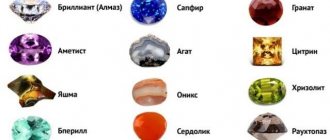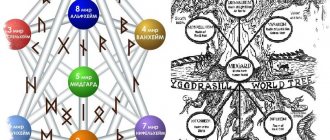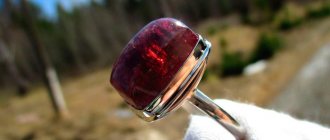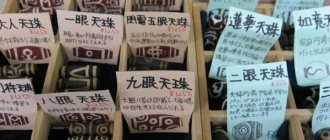How beautiful are all the minerals created by the Earth. They delight with their shades, brightness and saturation. Gems were created by nature itself and concentrated in themselves all its beauty, strength, power, and grace. Stones are endowed with unique abilities to cure ailments, restore strength, and improve well-being. This is an integral attribute of rituals and conspiracies. But there are representatives of the World of Stones with whom it is better not to deal. They pose a mortal danger to their owners, as well as those around them. It is worth talking about the most dangerous stones and minerals in more detail.
Cinnabar (HgS)
Mercury sulfide, better known as cinnabar, has been the main source of elemental mercury since the earliest days of human civilization.
Mercury has traditionally been used as a coloring agent for ceramics and tattoo ink, but in the modern world it is widely used in the creation of scientific equipment such as thermometers and barometers, as well as in a number of heavy industrial applications, such as the refining of precious metals and the production of chlorine. You should also not forget about mercury switches, which are used in some types of electronics. However, when oxidized, this element begins to produce methylmercury and dimethylmercury, two toxic components that can cause irreparable harm to the nervous system of children.
Even in small quantities, mercury is a deadly substance and can enter our bodies through the respiratory tract, food tract and skin. As a result, many enterprises have already completely abandoned or are beginning to abandon the use of this component in their industry.
Coloradoite - the poison of the gold rush
This mineral was first found in Colorado (USA) among igneous rocks, which is why it received its name. This unique rock is a mercury telluride often found near gold deposits. It even looks like a granular scattering of tiny mercury balls, shimmering in black and steel colors with a rainbow tint.
Such nuggets were often mistaken for gold in the USA and Australia during the gold rush. They indeed contain a small amount of precious metal. But the danger posed by the unusual breed far outweighs the possible benefits. If you take it in your hands and warm it with the warmth of the human body, the mineral begins to release deadly steam - the ingress of its particles into the lungs and digestive tract can cause the development of tumors, ulcers and scars. A similar effect occurs even if you simply place coloradoite in direct sunlight. Therefore, on hot days, any activity aimed at extracting this stone is suspended.
Pyrite (FeS2)
Sulfur and sulfuric acid are widely used in almost all industries.
Sulfur can be found in almost everything from matches and tires to fungicides (chemicals used to control fungal plant diseases) and fumigants (used to kill plant pathogens). In turn, sulfuric acid is a widespread component of many industrial processes, ranging from the production of dyes to explosives. And once upon a time, it was pyrite, formed by the combination of sulfur and iron, that was the only mineral and source for the extraction of these components. Soon, the increase in pyrite production began to cause serious harm to the environment, as the mined mineral began to pollute nearby groundwater reserves. In addition, pyrite has one unpleasant feature: when combined with coal and exposed to air, it can spontaneously ignite and release highly toxic metals such as arsenic upon oxidation. It is for this reason that many coal mines spray limestone powder to slow down the oxidation reaction of the ore and prevent it from spontaneously igniting.
Today, widespread commercial mining of pyrite is no longer carried out. Scientists realized that sulfur can be easily extracted as a bioproduct during the processing of natural gas and oil. Natural sulfur can now be mined only if samples are needed.
Black opal
Black Opal
The name does not accurately describe the appearance of this stone; in fact, it can be purple, blue and green with red flecks. Opal is considered throughout the world to be a very powerful amulet against the evil eye; it bestows success in work, happiness and love, helps develop talent, and improves mental activity. Sorcerers and shamans use it in various rituals. A talisman made of black opal protects against fire, thieves and lightning strikes. However, this stone helps only those who lead a decent life, without selfishness and greed.
Black opal is used to prevent cardiovascular diseases, depression, eye and nervous diseases. It helps with insomnia, improves immunity, male potency, and treats female infertility. Black opal tincture is used to treat colds and heart pain.
Fluorite (CaF2)
This amazingly beautiful green stone is called fluorite.
Composed of calcium fluoride, fluorite can often be found adjacent to deposits of ores such as iron and coal. This stone can be used to make melting flux, but is most commonly used to make jewelry and telescope lenses. When mixed with sulfuric acid, fluorite produces hydrogen fluoride, a very important chemical in the industry. However, fluorite can be dangerous for those who frequently wear jewelry made from it or for those who live near fluorite mines. That's because fluorite contains fluoride, a soluble mineral that can leach into groundwater sources and also be inhaled into the lungs if it is sprayed or burned in coal furnaces.
Once inside the body, fluoride can cause fluorosis - a very unpleasant and, pardon the tautology, painful sore that weakens our bones and damages connective tissues. Many rural communities in India, China and the rest of Southeast Asia suffer from outbreaks of this disease due to drinking contaminated water (in India) or inhaling the mineral (most often in China). In the Chinese province of Guizhou alone, about 10 million people suffer from the consequences of such infection.
Methods for refining stones
Above we have given a description of stones that are fraught with danger from nature. But there are also minerals that have become dangerous in the process of their refining. Radioactive radiation is one of the modern methods of refining gems, which is used everywhere. This method of changing the appearance of stones and their characteristics is quite effective and efficient, but it entails negative consequences, which are expressed in the deterioration of human health.
Even though radiation cannot be seen or felt with your hands, it is very dangerous. It turns out that objects that we love, value, constantly wear and under no circumstances want to part with can have a negative impact on the human body. If you conduct a radiological examination of jewelry that is stored in your home, the result may be very surprising. Some of them will emit radiation beyond the permissible limit. A person does not feel this, but the danger accumulates every day, and then results in negative consequences.
Not all stones are radioactively treated. Tourmaline, agate, amethyst, topaz, carnelian, and some beryl are mainly susceptible to irradiation. A mineral that has undergone radioactive treatment will be beautiful, bright, and refined with rich shades. This method is considered quite expensive, so in post-socialist countries another method was used - x-ray radiation. It is less dangerous, but significantly increases the level of radioactivity of gems. Therefore, before purchasing a very bright and saturated stone, it is worth thinking about its possible treatment using radiation.
Quartz (SiO2)
From optics and electronics to the production of abrasives and lighters (silica is produced from quartz), quartz is used everywhere.
Quartz is perhaps the most common mineral in the earth's crust and the most used by humans. Some believe its value in the production of igniters (it produces a long spark when rubbed against iron) even stimulated the development of mining in its time. Today, piezoelectric quartz crystals are integral components in radio electronics, as well as electronic watches. Just don’t even think about crushing and inhaling quartz, unless, of course, you want to develop a disease called silicosis. This respiratory disease is characterized by the formation of sealing tissue in the lungs and lymph nodes, which makes breathing very difficult. Typically, the disease may appear after about 20 years of exposure to such an environment, but in some cases, symptoms of the disease may begin to appear after 5-15 years. If you take and inhale a handful of quartz dust at once, the person will get acute silicosis, as a result of which the lungs will fill with liquid. Ultimately, a person will literally drown in the fluids secreted by his own body.
In addition, quartz dust can very easily cause lung cancer. Most often, inhalation of quartz dust causes occupational diseases, which occur when working in special enterprises such as mines, abrasives and glass production. In view of this, government health organizations in many countries have introduced rules for the mandatory use of respirators in such work.
Torburnite – mesmerizing and deadly beauty
This breed is named after its discoverer, the chemist Thorbern Bergman from Sweden. It occurs as a result of the interaction of water, copper, phosphorus and uranium. Such an unusual combination provides a rich dark olive color and an amazing structure of the mineral - its deposits (located in France, the Czech Republic, the Federal Republic of Russia, England, Poland and the USA) look like scatterings of emerald prisms! It is not surprising that even experienced crystallographers want to touch green stones and take a closer look at them.
But indulging such desires is extremely dangerous. Magic crystals are saturated with a gas called radon, as well as uranium. There is so much of the latter that these nuggets serve geologists as a reliable indicator of uranium deposits. These substances, as well as their breakdown products, emit radioactive alpha particles that destroy living cells . This process occurs as follows: microscopic pieces of the mineral enter the body with inhaled air or water. Long-term contact with them almost always ends in the development of lung cancer, leukemia or other serious diseases.
An ordinary person is unlikely to find his way into carefully guarded torbernite deposits or into laboratories studying it. But this does not mean that you are completely protected from poisonous stones. They can be contained in one of the most popular building materials - natural granite. Therefore, when choosing slabs for finishing your home, avoid those that contain attractive green inclusions!
Galena (PbS)
Galena is the main source of lead.
Lead has been used since ancient Roman times. The Romans used it for everything from making pipes and smelting to making paint and cutlery. We still use lead today. It is often found in batteries and bullets, as shielding (for example, for X-ray machines and in nuclear reactor vessels). In the past, it was used as an additive in paint and fuel, and was also used as a remedy against corrosive chemicals. It is not as dangerous as mercury, which will certainly kill you, but once lead enters your body, it cannot be removed from there. It will accumulate for many years inside the body and eventually reach a critical toxic concentration. Once this happens, your future children will have to pay. Not only can lead toxicity give you cancer, but it is also teratogenic, meaning it will cause birth defects in your children.
Cacoxenite
Cacoxenite
Cacoxenite is a very rare mineral, the name of which is translated from Greek as “bad guest.” This is due to the fact that it often contains phosphorus, which deteriorates the quality of the iron smelted from ore. Cacoxenite is a bunch of needle-shaped crystals of different shades: yellow, orange, green and red. Small particles of it can be found in quartz, amethyst and other minerals. Cacoxenite is a coveted find for collectors and is also used to make very beautiful jewelry. It is also used for the prevention of diseases of the cardiovascular system, thyroid gland and the treatment of colds.
Magicians use cacoxenite during meditation; It is also believed that it relieves phobias, mistrust and fatigue.
Phenakite (BeSiO4)
Phenakite is mined as a suitable material for jewelry production and as a valuable source of beryllium.
Previously, beryllium was used as the main source for the production of ceramic materials, but people soon learned that inhaling beryllium dust causes beryllium, an occupational disease characterized by inflammation of the connective tissues of the lungs. It is like silicosis, but much more serious and chronic. Beryllium disease cannot be cured by simply reducing the level of inhaled beryllium. If you develop beryllium disease, you will have to live with it for the rest of your life. In general, your lungs become hypersensitive to beryllium, which causes an allergic reaction in which small nodules, called granulomas, form in your lungs. Granulomas begin to make it very difficult for you to breathe, and in the worst case, they can also provoke a disease such as tuberculosis.
Malachite
Malachite
Malachite is a mineral that has attracted people's attention since ancient times with its unusual beauty and ease of processing. Its name consists of two Greek words: “mallow” and “soft”. This stone is a very beautiful shade of green with an iridescent unique pattern depending on the amount of copper and the presence of free cavities in the stone.
Since ancient times, malachite has been used to make boxes, vases, bowls, and to coat surfaces. Even ancient people believed that malachite repels all evil spirits and bestows fertility. Now many people wear malachite talismans to protect themselves from loneliness and depression, believing that the stone bestows spiritual strength, energy, harmony in the soul and attracts love.
Copper, which is part of malachite, also determines the healing properties of this mineral, since it can kill bacteria. It is no coincidence that the wealthy inhabitants of Ancient Rome preferred to drink from malachite bowls, believing that it improved digestion. Malachite was also used to make a drink that protected against poisoning.
Erionite Ca3K2Na2[Al10Si26O72].30H2O (Z = 1)
Erionite belongs to a group of zeolites, minerals that are similar in composition and properties and are often used as a molecular sieve due to their ability to selectively filter (through absorption) specific molecules from both the atmosphere and liquids.
Most often, erionite can be found in volcanic ash. It is used as a catalyst for precious metal alloying, hydrocarbon cracking (refining), and as a component for the production of fertilizers. Like many asbestos minerals, erionite can cause mesothelioma, a malignant tumor of the mesothelium (the tissue between organs). As soon as people found out about this (this happened in the late 80s of the 20th century), it was immediately decided to stop the extraction of erionite.
Orpiment - the death of artists
The name of the stone comes from Lat. "aurum" - gold and "pigmentum" - paint. Its deposits are found in Georgia, Armenia, Yakutia, Greece, Romania, Turkey and the USA. Amazing gold, yellow, saffron and orange crystals, reminiscent of a sparkling brush, look very exotic and tempting, but their shine is detrimental, because the cause of this color is carcinogenic and neurotoxic arsenic. There are cases where even a simple touch was enough to poison a person. In addition, the rock contains sulfur - because of this, deposits of the mineral are often located near hydrothermal vents.
But, despite its formidable reputation, orpiment was actively used in industry. In particular, it was very popular in China. When ground into powder, gold crystals were used to make durable and non-fading paint, although this cost the lives of many talented artists. In the Middle Ages, many icons were painted with just such a pigment, called “royal yellow”. Poison was also made from the mineral, which was used to smear the tips of spears and arrows.
Hydroxyapatite (Ca5(PO4)3(OH))
The phosphorus compounds in the garden fertilizers you use, as well as the phosphorus in the water that flows from your tap, most likely came from the same pebble as in the picture above. It's called apatite. This phosphorus mineral comes in three types, each containing increased levels of OH (organic and inorganic compounds), F (fluorine) and Cl (chlorine) ions. Hydroxyapatite, in turn, is the main component of our tooth enamel (as well as bones in general), while fluorapatite is something that is added to the water supply (it is also used in toothpastes) in order to avoid caries and strengthen enamel. And while having strong bones and teeth is a definite plus, spraying hydroxyapatite (through mining or processing) can cause this mineral to enter your body, travel to the heart and can cause hardening of the valves.
Arsenopyrite
Arsenopyrite is the main ore mineral for the production of arsenic and its compounds. It is often called fool's gold. Mistaking it for gold, they take it with them. If you do not wash your hands thoroughly after contact with the mineral and start cooking or eating with them, this can lead to serious consequences. With a small concentration, you can get away with fever, loss of appetite and insomnia; large doses threaten with vomiting, decreased blood pressure, dehydration and other disorders in the body.
Crocidolite (Na2(Fe2+,Mg)3Fe3+2Si8O22(OH)2)
Meet the most dangerous mineral on Earth - crocidolite, better known as blue asbestos.
Due to its strength, fire resistance and malleable nature, it was once widely used in a wide range of commercial and industrial applications, from ceiling tiles and roofing to decking and insulation. However, in 1964, Dr. Christopher Wagner identified a link between asbestos and mesothelioma (tissue damage between organs), after which blue asbestos almost immediately disappeared from the market. Unfortunately, many buildings built before this time and still standing today still contain blue asbestos.
Hutchinsonite
Thallium is lead's darker counterpart. This dense, fatty metal is similar in atomic mass to lead, but is even more deadly. Thallium is a rare metal that appears in highly toxic compounds consisting of rather strange combinations of elements. The effects of thallium exposure are even stranger, and include hair loss, serious illness upon skin contact, and in many cases death. Hutchinsonite is a dangerous but striking mixture of thallium, lead and arsenic. Three toxic metals form a deadly cocktail of minerals that must be handled with great care. Hutchinsonite was named after John Hutchinson, a famous mineralogist at the University of Cambridge. This mineral can be found in mountainous areas of Europe, most often in ore deposits.











